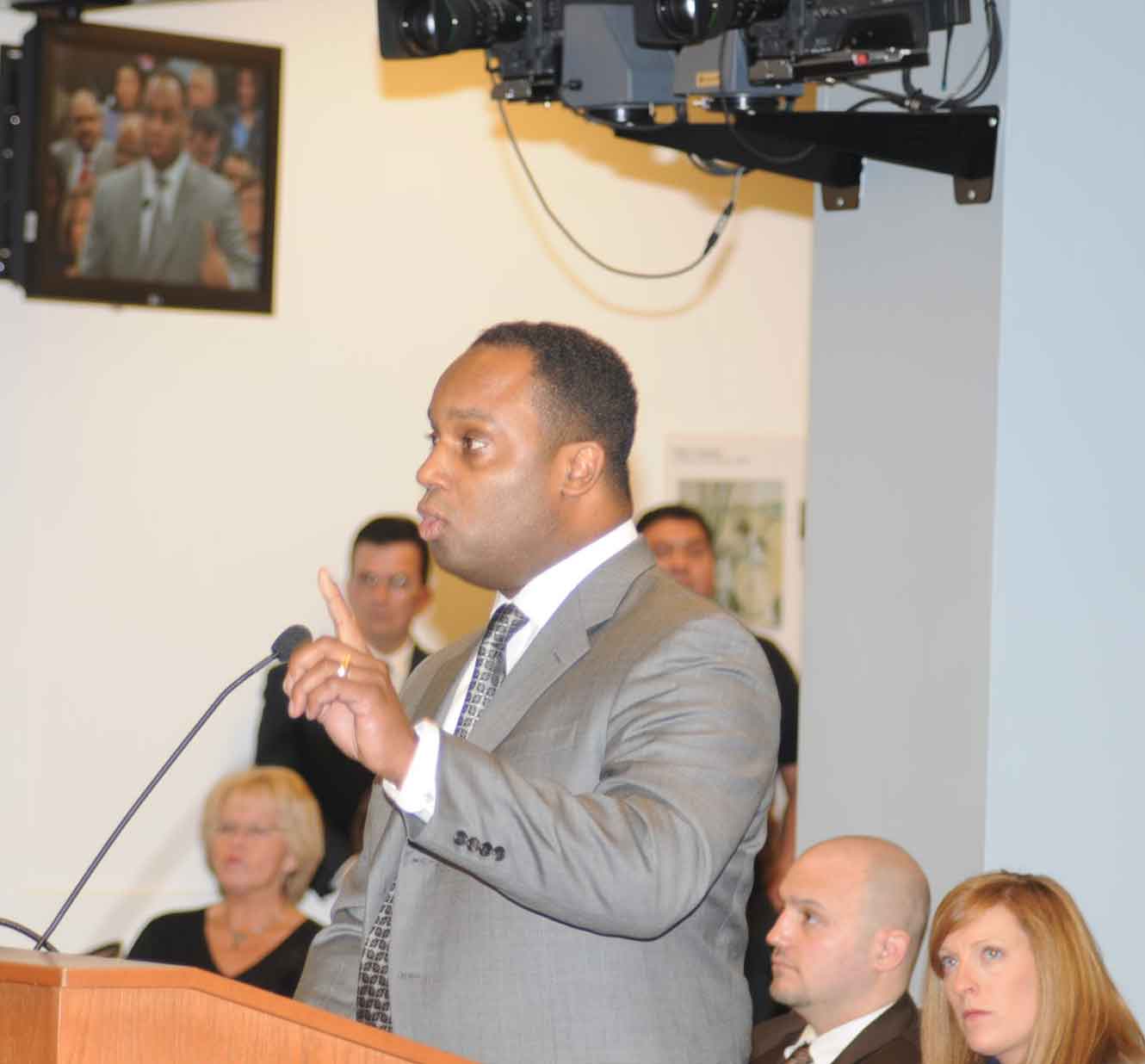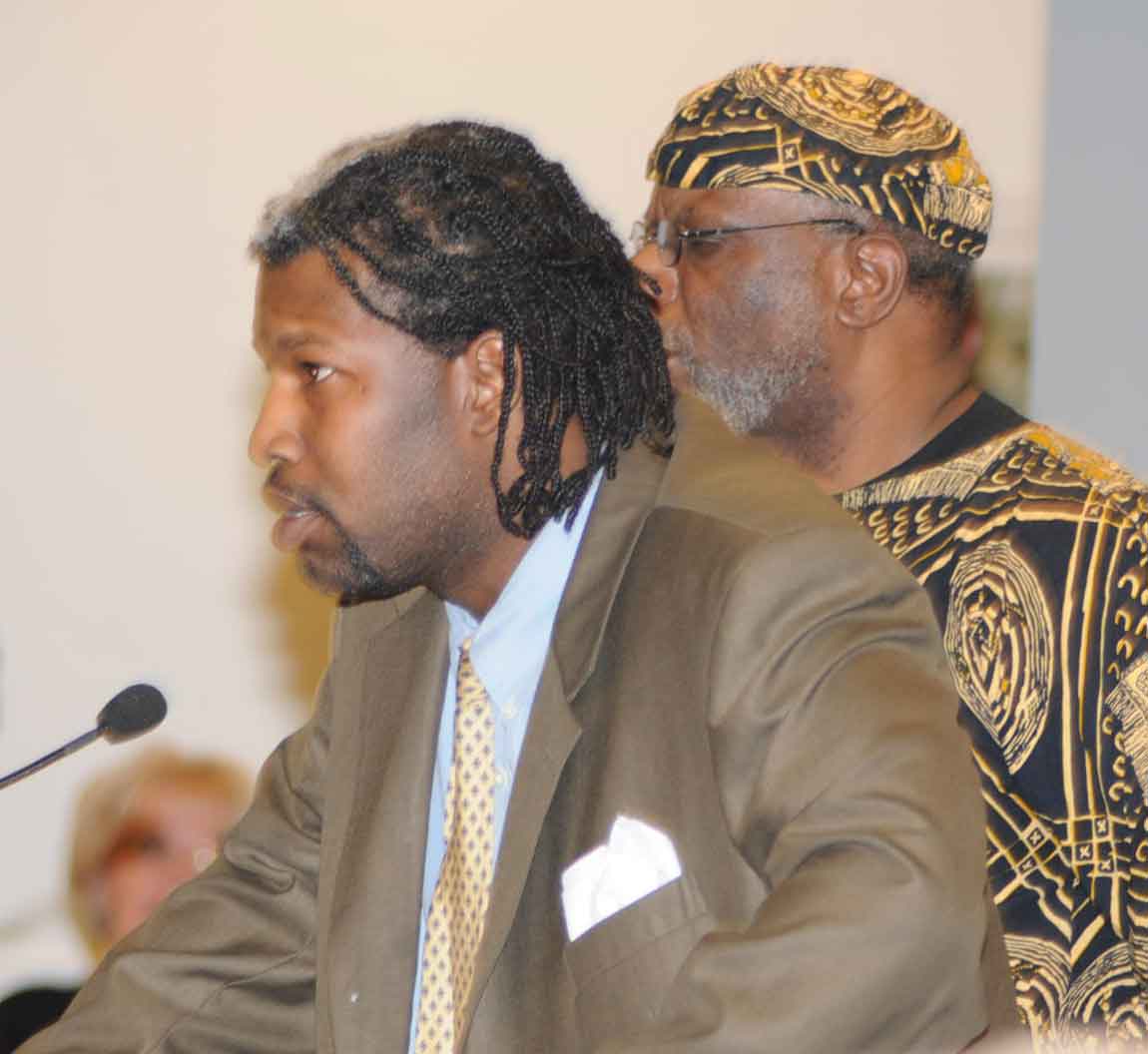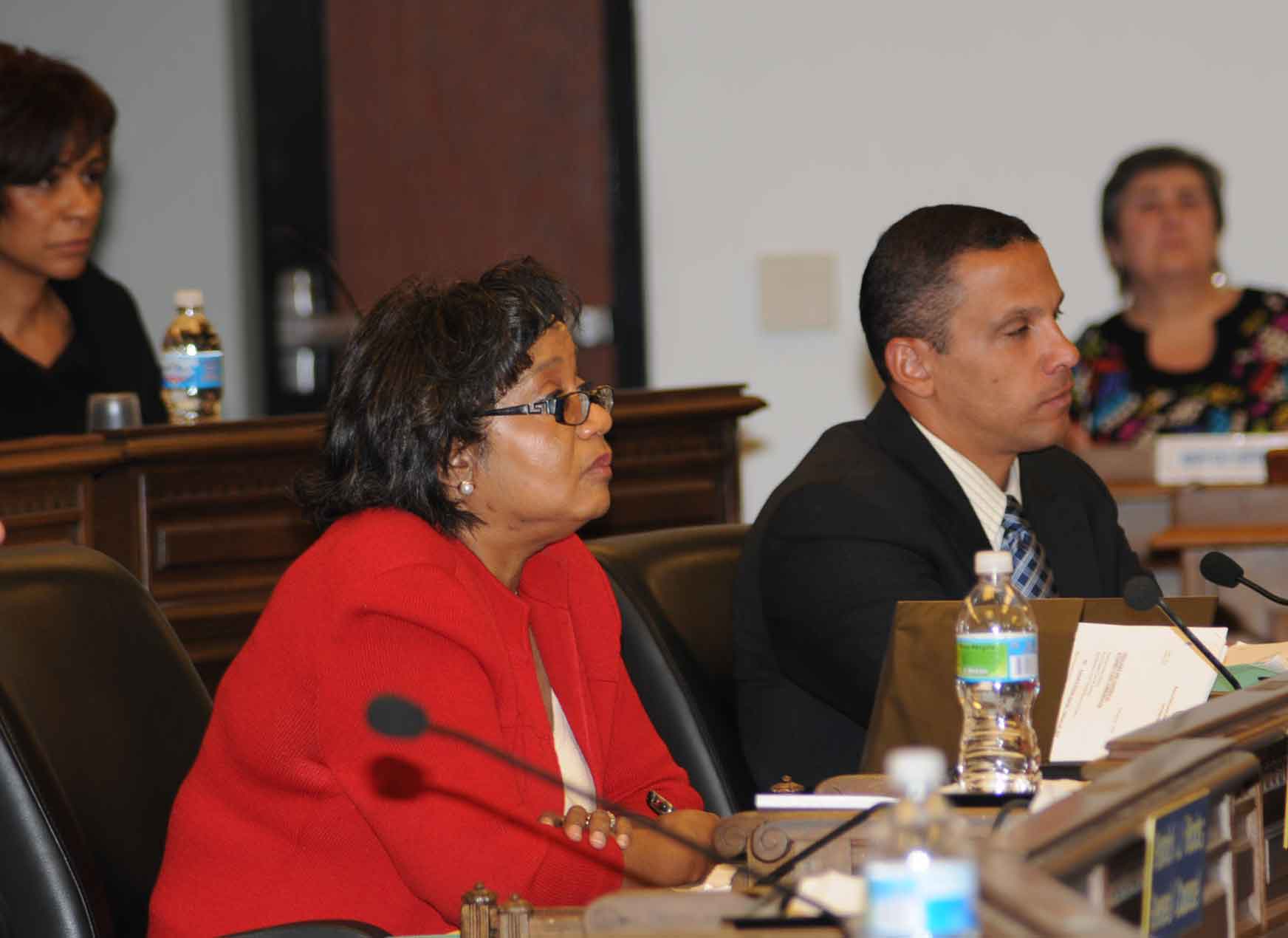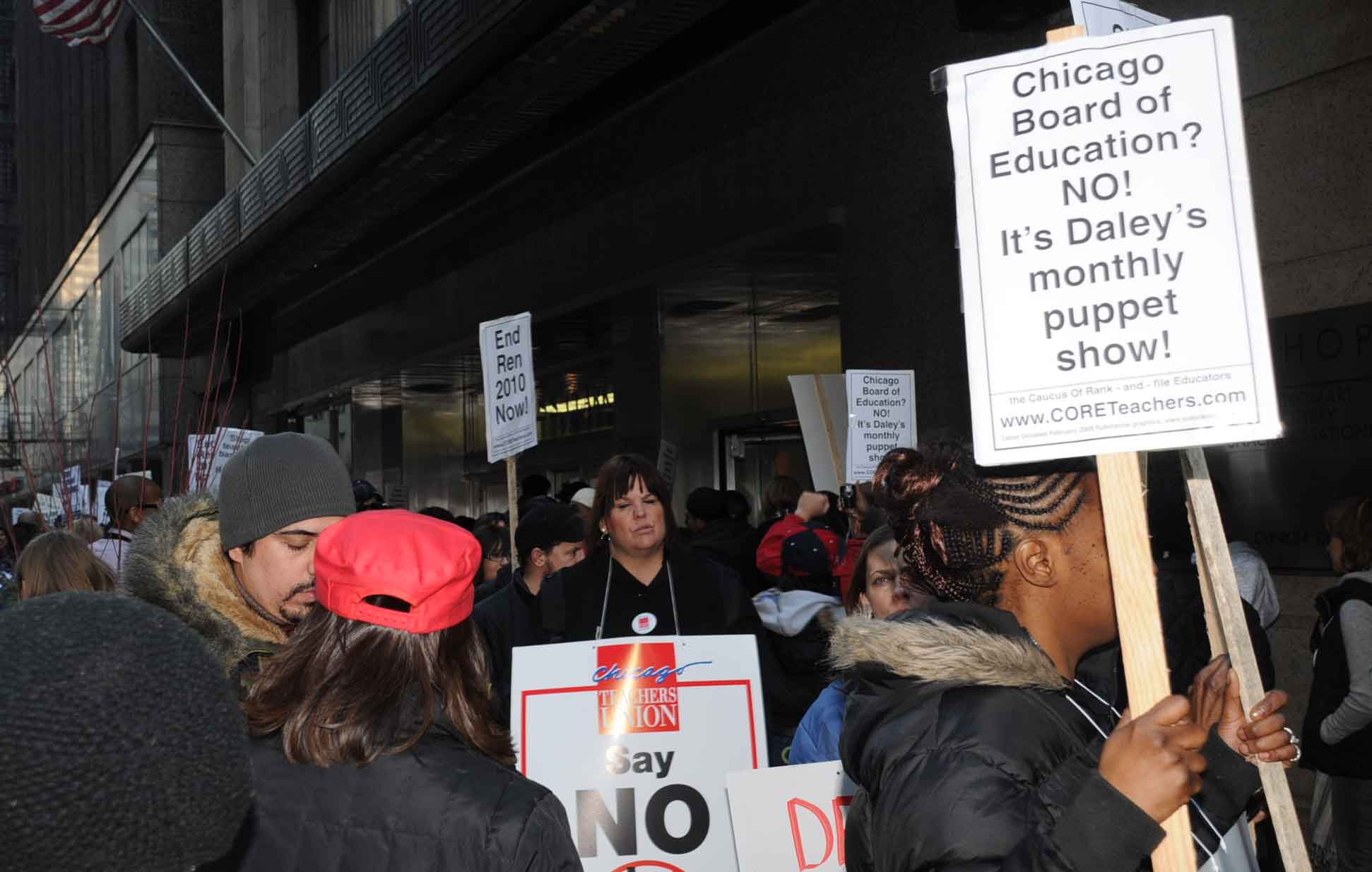Chicago Board of Education Hears -- and ignores -- Powerful Testimony to Stop Closings... Sixteen Chicago schools destroyed
It was night and day.
 Operation PUSH leader Jonathan Jackson (above at podium) told the Board of Education they should do a moratorium on all of the planned closings, phase outs, consolidations, and turnarounds. Jackson said he was driving past Holmes Elementary and decided to investigate himself when he read the school was going to be closed. Substance photo by George N. Schmidt. Last year, teacher bashing was the norm and opposition to Chicago Mayor Richard Daley’s Renaissance 2010 plan isolated and marginalized. The Chicago Board of Education voted at its February 27, 2008 meeting to close all the proposed public schools on the 2008 "Hit List" (as parents, teachers, and students had taken to calling it). Then they took the time to further denigrate the schools the were destroying.
Operation PUSH leader Jonathan Jackson (above at podium) told the Board of Education they should do a moratorium on all of the planned closings, phase outs, consolidations, and turnarounds. Jackson said he was driving past Holmes Elementary and decided to investigate himself when he read the school was going to be closed. Substance photo by George N. Schmidt. Last year, teacher bashing was the norm and opposition to Chicago Mayor Richard Daley’s Renaissance 2010 plan isolated and marginalized. The Chicago Board of Education voted at its February 27, 2008 meeting to close all the proposed public schools on the 2008 "Hit List" (as parents, teachers, and students had taken to calling it). Then they took the time to further denigrate the schools the were destroying.
In February 2008, Chief Education Officer Dr. Barbara Eason-Watkins ridiculed the teachers at one of the proposed "turnaround" schools. "Tuarnaround" is the word the Chicago Public Schools have been using since last year to mean the process of "Reconstitution". Under "reconstitution", a school is declared a failure by school system officials and the entire staff is replaced. But since reconstitution has been a failure across the nation (as well as in Chicago, where it was used during the mid-1990s), Chicago introduced the corporate term "turnaround" in late 2007 to mean the same thing.  Willie Fleming (above at microphone) told the Board of Education members that closing Schiller Elementary School was a violation of the human rights of the families whose children attend Schiller. Fleming pointed out that poor families were promised the "right of return" to homes in Cabrini-Green, and that the population of Schiller was very likely to begin increasing. Fleming was noting the interrelation of the destruction of much of Chicago's public housing and its impact on the schools serving poor children during the February 25, 2009 Chicago Board of Education meeting. Substance photo by George N. Schmidt.In February 2008, Eason-Watkins noted that some of the schools on the Hit List had a high absence rate and low test scores. Arne Duncan held a press conference saying that he had a moral obligation to close "failing" schools. Board members laughed out loud at how community members would want to keep “failing” schools open.
Willie Fleming (above at microphone) told the Board of Education members that closing Schiller Elementary School was a violation of the human rights of the families whose children attend Schiller. Fleming pointed out that poor families were promised the "right of return" to homes in Cabrini-Green, and that the population of Schiller was very likely to begin increasing. Fleming was noting the interrelation of the destruction of much of Chicago's public housing and its impact on the schools serving poor children during the February 25, 2009 Chicago Board of Education meeting. Substance photo by George N. Schmidt.In February 2008, Eason-Watkins noted that some of the schools on the Hit List had a high absence rate and low test scores. Arne Duncan held a press conference saying that he had a moral obligation to close "failing" schools. Board members laughed out loud at how community members would want to keep “failing” schools open.
Even though the overwhelming majority of the people who testified at the hearings in 2008 opposed the changes and provided factual evidence to refute many of the claims made by CPS representatives, the combined voices of hundreds who spoke and thousands who attended the hearings were not enough to stop the Board from simply voting, without discussion or debate, to destroy the schools on the 2008 "Hit List."
For the past several years, community activists, teachers, parents, and students have been referring to final list of schools created for the annual ritual of closing (or otherwise terminating public schools in Chicago) as the "Hit List."
2009 was different
This year, the Board of Education members did not bash the teachers or communities publicly.  Chief Education Officer Barbara Eason Watkins (wearing glasses above) and Chief Executive Officer Ron Huberman (to Eason Watkins's left, above) listen while Willie Fleming asks that Schiller Elementary School not be closed. In the far left corner of the above photograph is Chicago Board of Education member Peggy Davis, a wealthy lawyer for Commonwealth Edison (Exelon). A few hours after the Fleming testimony, Davis joined the other members of the Board of Education in voting to close Schiller. Substance photo by George N. Schmidt.The newly appointed CEO did not hold a press conference to belittle the schools he was ordering destroyed. Instead of being allowed to make comments about how parents, teachers, and students were trying to defend "failing schools," the seven members of the Chicago Board of Education had to defend and explain themselves. They were asked to state that they attended the public hearings that had been held between January 26 and February 11 regarding the 22 schools that had been placed on the 2009 "Hit List." Speakers demanded to know how many hearings the seven members of the school board had actually attended, and how much of the thousands of pages of testimony and other materials provided by parents, teachers, students and others they had actually bothered to read.
Chief Education Officer Barbara Eason Watkins (wearing glasses above) and Chief Executive Officer Ron Huberman (to Eason Watkins's left, above) listen while Willie Fleming asks that Schiller Elementary School not be closed. In the far left corner of the above photograph is Chicago Board of Education member Peggy Davis, a wealthy lawyer for Commonwealth Edison (Exelon). A few hours after the Fleming testimony, Davis joined the other members of the Board of Education in voting to close Schiller. Substance photo by George N. Schmidt.The newly appointed CEO did not hold a press conference to belittle the schools he was ordering destroyed. Instead of being allowed to make comments about how parents, teachers, and students were trying to defend "failing schools," the seven members of the Chicago Board of Education had to defend and explain themselves. They were asked to state that they attended the public hearings that had been held between January 26 and February 11 regarding the 22 schools that had been placed on the 2009 "Hit List." Speakers demanded to know how many hearings the seven members of the school board had actually attended, and how much of the thousands of pages of testimony and other materials provided by parents, teachers, students and others they had actually bothered to read.
After the agenda for the February 25, 2009 meeting was made public at 10:00 a.m. on January 23, something unprecedented took place — the proposals were reviewed and changes were made.
The original 2009 Hit List had been made up by former Chief Executive Officer Arne Duncan. By February 25, 2009, however, Duncan was in Washington, D.C. after being appointed U.S. Secretary of Education by President Obama. All 22 of the schools on Duncan's Hit List were recommended for closing (consolidation, phase out, or turnaround) on the original public agenda for the February 2009 meeting.
But by the evening of February 23, the Board of Education announced that six of the 22 schools had been removed from the Hit List after what it said had been a review conducted by the new Chief Executive Officer, Ron Huberman.
So by the time the Board of Education meeting was called to order on February 25, board members were careful about the words they chose before voting to close the 16 schools on the newly revised and updated list.
Barbara Eason-Watkins, who had supposedly been a front runner to replace Arne Duncan as Chief Executive Officer (CEO) of the Chicago Public Schools, did not say one word.
 After the public participation portion of the February 25 Chicago Board of Education meeting finally ended at nearly 2:00, many of those in attendance went downstairs to join the large march against Renaissance 2010. The picket (above) and march, which began at around 3:45 p.m., filled the sidewalk in front of the Board's headquarters at 125 S. Clark St. before turning north and marching to the State of Illinois Building (the Thompson Center) four blocks to the north, where a rally was held. Many of the protesters, however, did not join the march. Instead, they waited upstairs in the Board chambers for the Board to come out of its "executive session" and actually vote on the agenda that would seal the fate of 16 public schools slated for phase out, closing, consolidation and "turnaround." Substance photo by George N. Schmidt. Last year not one Board of Ed member attended a public hearing for the closing schools. This year several members attended the hearings (at least one of them), and (then) Board president Rufus Williams, recently replaced by veteran Michael Scott, even went out to visit the Holmes Elementary school the day after he attended its hearing. That school was then taken off the 'turnaround' list in which every employee in the building was to be fired.
After the public participation portion of the February 25 Chicago Board of Education meeting finally ended at nearly 2:00, many of those in attendance went downstairs to join the large march against Renaissance 2010. The picket (above) and march, which began at around 3:45 p.m., filled the sidewalk in front of the Board's headquarters at 125 S. Clark St. before turning north and marching to the State of Illinois Building (the Thompson Center) four blocks to the north, where a rally was held. Many of the protesters, however, did not join the march. Instead, they waited upstairs in the Board chambers for the Board to come out of its "executive session" and actually vote on the agenda that would seal the fate of 16 public schools slated for phase out, closing, consolidation and "turnaround." Substance photo by George N. Schmidt. Last year not one Board of Ed member attended a public hearing for the closing schools. This year several members attended the hearings (at least one of them), and (then) Board president Rufus Williams, recently replaced by veteran Michael Scott, even went out to visit the Holmes Elementary school the day after he attended its hearing. That school was then taken off the 'turnaround' list in which every employee in the building was to be fired.
Last year Chicago Teachers Union President Marilyn Stewart did not attend one public hearing and did not even attend the February 27, 2008, Board meeting that voted to close the schools. This year, she attended many -- not the majority -- of the public hearings and spoke out passionately against the closings. CTU officials were present and spoke out at the majority of the hearings.
Last year every school on the closure list was voted to close except Abbott which had a state-mandated pre-school program and a charter school operating inside the building; this year six schools were taken off the list after massive protests and a strong collective anger was directed at the Board and the Union.
The only public official to attend the Board meeting was Alderman John Pope, who stood beside over a dozen Gallistel parents and teachers who want one renovated building to serve an overcrowded school population that features three campuses.
After Alderman Pope finished, CTU President Marilyn Stewart began the protests against the school closings, consolidations, phase outs and "turnarounds." She first thanked the newly appointed schools’ Chief Executive Officer (CEO) Ron Huberman for taking the six schools off the closure list, but stressed the importance of a moratorium because of “shady data” used to close the schools. She said an outside independent organization is needed to investigate the school closing process.
Next Jonathan Jackson, the son of Jesse Jackson and a representative of Operation PUSH, spoke out against the school closings, noting that they are contributing to the escalating crime rate in Chicago, which is now the most violent ci ty in the country. Jackson then questioned why certain people were allowed to speak before others who stood in line for a long time. Rico Gutstein, a professor at UIC and member of GEM the Grassroots Education Movement, then broke protocol and challenged Board President Scott about allowing defenders of AUSL – the management company contracted out to run “turnaround” schools - to move ahead of the speakers on the list, giving the impression that they wanted to strategically squash the school closing protests.
“The Board lacks the moral authority to close these schools,” Gutstein told the Board. “The Board should have the moral courage to stop the closings until a community driven process has been put in place.”
Laura Krejca, the librarian at Holmes Elementary School and a member of CORE, the coalition of rank and file teachers who helped ignite the protest movement this year, said even though her school was taken off the list, she was here at the board to defend the other schools still on the list.
“We have kids who don’t have the proper clothing, are homeless and you’re throwing them out like they’re yesterday’s trash,” she said. “Our kids are so worried now, how do you think their test scores are going to turn out?”
The first of a few principals to speak out was Frederico Flores of Peabody Elementary, a school also taken off the list but nonetheless showed up at the Board meeting to pledge support for all the public schools on Daley’s hit list.
Flores noted that their successful school — one of only 35 CPS schools taken off the onerous NCLB list — was denied crucial funding this year because they were put on the closure list. He asked the Board that the funding be restored.
An impassioned plea for a moratorium on school closings was punctuated by Schiller parent Willie Fleming who said according to the UN charter on human rights, the housing project people have a right of return to their local schools. He also said the school closings are directly responsible for the spike in violence.
One question that was never answered at the Board, was why take Peabody Elementary off the closure list and not Carpenter, the other school in Rep. Cynthia Soto’s district that sparked her to introduce a bill to put a moratorium on school closings until more community input is generated.
“No Board members have come to our school,” said parent Maria Hernandez, who attended a candlelight vigil in front of the Board the night before. “Ogden which has the money and connections will be kicking us out. They are kicking our community out.”
Hernandez was referring to the fact that the Board had decided to create something called "Ogden High School" out of the Ogden Elementary School, located in one of the wealthiest communities in Chicago, the Gold Coast. The decision to crete "Ogden High School" was never seriously debated by the Board, and when the people at Carpenter learned that "Ogden High School" was going to be created by destroying Carpenter Elementary School, they were angry.
Also, why would Carpenter be closed for "underutilization" if more space is needed for students mandating special education services, another community member asked. More research is needed when the new schools under Renaissance 2010 are excluding neighborhood children, especially the Latino and African American kids, said Jane Fleming.
“I’m not sure this is not at odds with NCLB and I’m not sure that you know, so you should postpone your votes to close these schools,” said Fleming, a member of Carpenter’s LSC.
Likewise, why take Las Casas Occupational High School (which provides services for emotionally challenged youth) off the list and not Davis Developmental which provides crucial services for some of the most physically challenged young children in the city? Davis teacher Susan Reynolds noted that after a walk-through to observe the school, they said they would like to clone the staff. However, much of the staff will be lost after the school is consolidated.
Sporadically interspersed were charter school administrators, teachers and students who tried to promote their schools in a meeting focused on the school closings. One charter school student said he wanted to be included on a panel of high school students.
Bethune Elementary School principal Dianne Jackson noted that there have been four different administrations at the school in the last five years. “Bethune has already been turned around," she told the Board. "Let’s give the kids some consistency in their lives.”
The Board voted to turnaround Bethune anyway. Turnaround means that all of the staff will be fired, according to the Board Report passed quickly by the Board late in the afternoon of February 25.
Many CORE members spoke out against the closings, including Jackson Potter, Eric Skalinder, Kurt Hilgendorf, Carol Caref, Xian Barrett, Earl Silbar, Laura Krejca, Norine Gutekanst and Kristine Mayle. Arguably the most memorable line of questioning came from Mayle, whose school (De La Cruz) is scheduled for closure at the end of this year. She looked hard at the Board members and asked if any had actually read the transcripts at all the Board hearings. There were more than 22 hearings, and none of the Board members had bothered to attend more than two, so they hadn't listened to the testimony. Had they bothered to read what hundreds of parents, students, teachers, principals and community leaders had said?
No.
With many eyes down, not one hand was raised amidst gasps in the audience.
“This is like a cruel fairy tale,” Jackson Potter told the Board. “School choice is like asking if you would like to keep your hand or your foot. Mr. Huberman, you have to stop the Tsunami of school closings and take all this into consideration. I encourage you support to the Soto moratorium.”
Several Robeson High School and Julian High School students spoke out as well.
“There’s too much adult business talk here,” Kellina Mojica from Julian noted, “and not enough children.” At this point, Michael Scott recommended a panel of many different students to give their input into these matters.
Unlike former Board president Rufus Williams, Scott, brought in the last minute by Daley, ran a much smoother and less acrimonious meeting.
Scott showed his smoothness by not challenging or upsetting the speakers, whereas Williams would take pleasure in picking apart arguments or demeaning some students if he could question their facts or the logic. To counter the powerful testimonies against the public school closings, a few parents at schools that were “turnaround” touted the positive change under Renaissance 2010. Adrienne Leonard, a member of Parents for School Choice (RSF) said failing schools is not acceptable and her only complaint is the need to lift the cap on charter schools.
But overall, the arguments were strong, persuasive and extremely articulate – put a stop to school closings until CPS has a sound plan in place that will address the damage it is doing to children across the city.
Huberman, who was mostly silent during the entire hearing, spoke a little after a Board presentation was made outlining the criteria to close the 16 schools.
“The six schools not on the list were because we were open,” he said. “We want to take a look at this process and ways we can improve it. It’s a good process and we need to take it to the next level. We need to find ways to make it more transparent. It’s always a difficult decision to close schools, but I believe it was the right thing to do.”
Certainly the Board members, hand-picked by Mayor Daley and representing top corporate interests, many of whom have invested a lot of money into the Renaissance School fund that has helped to undermine the neighborhood public schools, agreed. They once again voted to close all 16 schools recommended by the Board despite the compelling evidence and community outrage.
Substancenew.net, February 28, 2009. Posted March 2, 2009.
Comments:
By: Michaelmar
ZennoDroid – automation for Android apps.
ZennoDroid mimics the work of a human in Android. It is powered by MEmu emulator.
You perform some activities in Android emulator, and the app records them to the project.
You can edit it, add new steps or logic.
When you launch the project, ZennoDroid will do everything for you!
Powerful technologies to bring your ideas into fruition.
- Full Android automation via MEmu
- Multi-threading
- Device parameters emulation
- Integration with 35 services
- User emulation system
- Virtual machines management
By: Michaelmar
XRumer software package.
XRumer — a multifunctional tool for comprehensive promotion on the Internet.
The program is able to place your links and ads for more than 15,000,000 (15 million!) in a short time resources — forums, blogs, guest books, link catalogs, bulletin boards, social networks.
Unique feature: fully automatic captcha bypass.
The program is able to recognize and bypass more than 12,000 types of popular captchas during registration and posting, including such complex ones as reCAPTCHA (v2, v3, Enterprise), hCaptcha, FunCaptcha, Yandex-captcha, vBulletin-captcha, DLE-captcha, VKontakte and Facebook captcha, etc.


By: Michaelmar
ZennoPoster - Automate any web tasks.
Automate any web tasks – increase your efficiency. Join the community of 15,000+ users and create your first bot today!
ZennoPoster mimics actions performed by a human in the browser, or actions of the entire team of humans (in Pro version).
Fits absolutely everyone.
- Easy start — anyone can manage it
- Codeless programming
- Flexible interface customization
You perform actions on the site, and the app records them to the project. You can edit the project, add new steps or logic.
Launch the project and ZennoPoster will do everything for you!